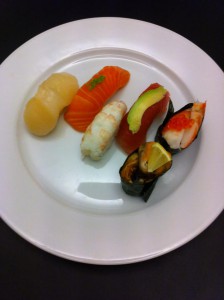All countries in Scandinavia have tasty salmon.
At the moment, the salmon comes primarily from Norway, Iceland and the Faroe Islands. Some salmon are better than others.
As a sushi chef, I am very particular about the quality of fish, only the best is good enough.
I use only the best fish when I hold Sushi course and Japanese cooking course. It tastes the best, but it also minimizes the risk of diseases.
The Faroe Islands are the country in the world that has the best salmon.
Salmon that have lived in the sea under the best conditions and that have had the best food throughout their upbringing.
This particular salmon is used when we make the popular Japanese dish teriyaki salmon from scratch on the course Traditionel Japanese cooking class for beginners.
Read more about the course Traditional Japanese cooking class for beginners
_
Zoë has held sushi courses and cooking classes for A. P. Moller – Maersk, Hugo Boss Nordic, Novo Nordisk, Novartis, Velux, Gorrissen Federspiel, Beierholm revision, Elbek & Vejrup and many more.








